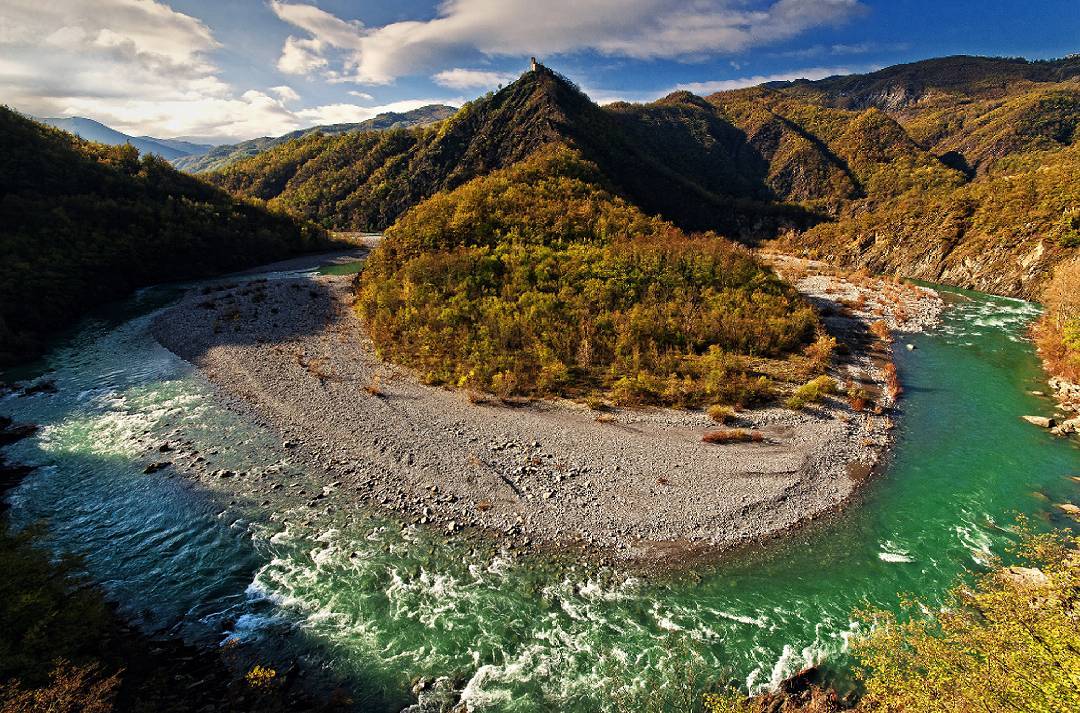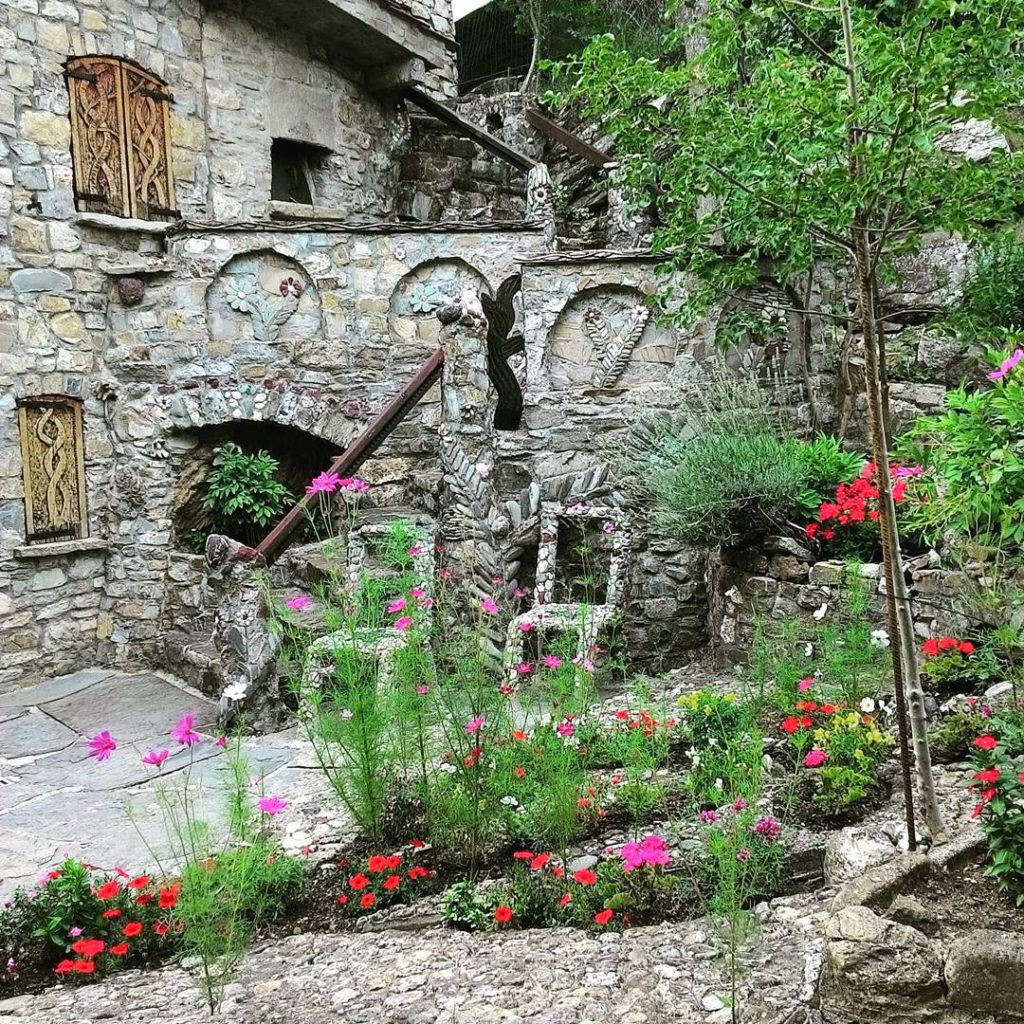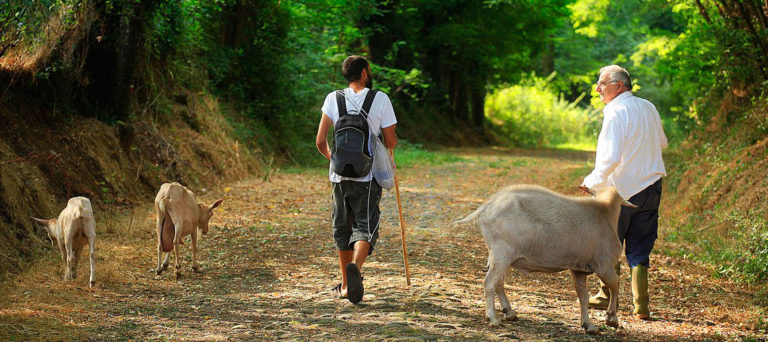Let’s face it: to take a leisure weekend with your loved ones is not only beautiful, but also necessary to get away from the everyday routine. That’s the reason why the autumn of a few years ago we decided to spend a weekend in our Emilia-Romagna to discover some corner still unknown to us.
We decided to explore the hinterland of Piacenza and the choice fell on the small village of Brugnello, in the high Valley of the Trebbia River (defined by Hemingway the most beautiful valley in the world), on the border with Lombardy, Liguria and Piedmont. Choice more than apt, since we were looking for villages to discover, relax and contact with nature.
If this is the kind of village that’s right for you, here is some info.

Trebbia River seen from Brugnello Ph. @monika_fotografie
Brugnello, suggestive village of the Trebbia Valley
Brugnello, 464 meters above sea level, is one of the most suggestive villages of the Trebbia Valley: it is part of the Municipality of Corte Brugnatella, which took its name from the Brugnatelli, a native noble family.
To reach it, you have to drive from the SS45 through a very narrow road with hairpin turns (about 2 km): challenging, especially if you suffer carsickness, but I assure you that the offered panorama repays the effort.
The entrance to the village is marked by a hand-written sign, and immediately we understand that we have come to a magical place, out of time and space (we could be in France, Germany or England), almost out of reality.
The small village perched on a rocky spur, once fortified, today presents itself to the visitor as an original cluster of a few old stone houses partly dug into the rock and a church, which have retained the medieval style, although enriched by the artists that contributed to the restoration, making it a village of fairy tales.
Balconies and flowerbeds, wooden doors and shutters, alleys and houses enriched with floral stone decorations and some chairs and bench, always made of stone, waiting to be used by the next visitor / tourist who wants to enjoy good air and take some rest.
Walking through the village it is evident the love of its inhabitants, who keep it clean and perfectly preserved.
Climbing along the only narrow road, you arrive in the square of the church at the top of the village, which seen from the SS45 coming from Bobbio seems more impressive than actually is, but from which you can enjoy a view above Trebbia River that compares with no other: a privileged point of view on a place where the river is forced by nature to flow encased in magnificent meanders by drawing loops that curve on themselves.
Despite the size of the village (just 11 inhabitants, excluding the owners of second homes), it is also possible to stay in the small hotel with restaurant run by generations of Chiara’s family, for a stay that allows you to enjoy the magical “slow time” of these historic settlements in direct contact with nature.
From there, we also took the opportunity to visit the nearby village of Bobbio (20 minutes by car), a town recognized as one of the Most Beautiful Italian Villages and by the Orange Flag, where you can appreciate among other things the medieval Abbey of San Colombano, the Roman hunchbacked bridge (also called Devil’s Bridge, Ponte del Diavolo) and the medieval Malaspina del Verme Castle.
If you are a fan of outdoor sports, Bobbio is also the ideal starting point for practicing sports in a natural and evocative environment. A recommended excursion, which I still remember with great pleasure and a bit of nostalgia, to the rediscovery of fairytale and dreamlike places that our region can offer, even if often little known.
History
The first reliable documents date back to the Longobard era (about 580 AD) when Corte Brugnatella was mentioned and it seems that a royal court had been established in Brugnello.
In the Middle Ages the Brugnatelli Family built a castle, which during the second half of 1100 Federico Barbarossa granted for three quarters to the Malaspina Family and only a quarter to the Brugnatelli Family, before passing under the control of Galeazzo Visconti in 1361.
Unfortunately, of this castle only few stone remain today.
In 1923 the Municipality passed from the Province of Pavia to the Province of Piacenza.
What to see
The small Church of Cosma and Damiano, patrons of the Medici, dates back to the XI century but has been remodeled several times in the following centuries. Composed of a single nave, it has a plastered and painted baroque facade, which seems almost laying on the oldest stone structure.
What to do
Winter
– Downhill skiing at Passo Penice.
– Cross-country skiing in Vallette: 10 km of track with rings of 7 – 5 – 3 or 2 km.
Spring
– Rafting, canyoning or kayaking on the Trebbia River.
– Go hiking along the many local paths with different lengths and difficulty (from 5 – 10 or up to 20 km) or enjoy the beautiful mountain scenery in MTB for a healthy dip in nature.
Summer
– Take a bath in the clear and bathing waters of the Trebbia River and sunbathe in complete tranquility.
– Go fishing for trout and grayling, prey craved by fishermen from all over Italy.
Autumn
– Go searching for mushrooms, truffles and chestnuts in the surrounding woods.
– Go hiking or mountain-biking.
Food and Wine
Like all the mountain kitchens, the food tradition of Brugnello is mainly based on the abundant natural resources of this area such as mushrooms, truffles, chestnuts and wild berries, without forgetting that the territory of Piacenza includes 3 DOP cured meats (coppa, pancetta and salami) and over twenty DOC wines.
In local restaurants you can taste genuine traditional recipes, which obviously show the geographical position of the Trebbia Valley. Each neighboring region has characteristics that the Piacenza cuisine has been able to absorb and reprocess: the cured meats and stuffed fresh pasta (such as tortelli) of the Emilian tradition; the risotto of Lombard and Piedmontese heritage; the lüganega, that is the sausage of Lombard-Venetian origin; the great use of vegetables, legacy of the Ligurian cuisine.
Monumental Trees
If you love nature, and in particular the trees, we point out the monumental ones in the area:
– the oaks woods surrounding Corte Brugnatella Pieve Montarsolo (for a total of 230 specimens);
– the sycamore in Piazza S. Francesco in Bobbio;
– the oak in Cascina Stavello, in Vaccarezza (Bobbio).
Pilgrim paths and walking trails
Notice that the first regional stop of the Abbots Way, also called “Francigena Way of mountains” (the road that, starting from Pavia, crosses the Tuscan-Emilian Apennines toward Lucca and Rome) starts right from Bobbio, a few kilometers from the village.
How to get to Brugnello
from Bologna: A1 to the exit of Piacenza Sud, then SS45 Val Trebbia towards Genova – 207 km
from Genoa: SS45 Val Trebbia – 80 km
from Milan: A1 to the exit of Piacenza Sud, then SS45 Val Trebbia towards Genova – 131 km
from Turin: E70 to the exit of Piacenza Ovest, then SS45 Val Trebbia towards Genoa – 235 km
Author
You may also like
[Emilia Romagna Villages] Bobbio: a town of cinema and legend
by Arturo Castellini /// October 10, 2017

Interested in our newsletter?
Every first of the month, an email (in Italian) with selected contents and upcoming events.
Emilia Romagna Slow | The Francigena Way
by Walter Manni /// May 2, 2017
by Walter Manni ///











![[Emilia Romagna Villages] Bobbio: a town of cinema and legend](https://www.travelemiliaromagna.it/wp-content/uploads/2021/06/photo-768x576.jpg)

